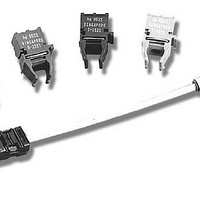HFBR-0536Z Avago Technologies US Inc., HFBR-0536Z Datasheet - Page 3

HFBR-0536Z
Manufacturer Part Number
HFBR-0536Z
Description
KIT EVAL FIBER OPTICS 32MBD
Manufacturer
Avago Technologies US Inc.
Specifications of HFBR-0536Z
Main Purpose
Interface, Fiber Optics
Embedded
No
Utilized Ic / Part
HFBR-1527Z, HFBR-2526Z
Primary Attributes
650nm, 32MBd, TTL
Operating Voltage
5 V
Description/function
Versatile Fiber Optic Evaluation Kit
Maximum Operating Temperature
+ 85 C
Minimum Operating Temperature
- 40 C
Operating Current
6.2 mA
Silicon Manufacturer
Avago
Kit Application Type
Communication & Networking
Peak Reflow Compatible (260 C)
Yes
Leaded Process Compatible
Yes
Rohs Compliant
Yes
For Use With/related Products
HFBR-1527Z, HFBR-2526Z
Lead Free Status / RoHS Status
Lead free / RoHS Compliant
Secondary Attributes
-
Lead Free Status / Rohs Status
Details
Other names
516-2321
Figure 2. Attributes of Encoding
Burst-mode serial communication systems also have
some interesting characteristics. They usually require
more communication channel bandwidth, since the
most common burst-mode protocols normally use a
Manchester encoder, which transmits more than one
symbol for each bit. Figure 2 shows how the commu-
nication channel’s bandwidth must increase when the
Manchester code normally used in Ethernet data com-
munication systems is applied to unencoded serial data.
The big advantage of encoding is that it merges the
clock and data so that only one communication channel
is needed for both signals. In most high-performance fi-
beroptic communication systems, the data and clock are
merged onto a single serial channel using a method that
has better efficiency than Manchester encoding. Figure
2 shows several common encoding methods with better
efficiency than Manchester code. Other important re-
lationships between bits/second, and symbols/second,
expressed in Baud (Bd) are explained by Figure 2. Note
that arbitrary duty factor unencoded data is one of the
few instances when data rate in bits/second, and the
symbol rate in Bd are equal. Relationships between the
signaling rate expressed in Baud and the fundamental
frequency of digital data communication signals are
also shown in Figure 2.
Burst-mode communication protocols are used in
popular serial communication systems such as Ethernet,
or Arcnet. Burst-mode protocols allow many network
users to share a common pair of copper conductors
with a tapped connection for each user network inter-
face. The key disadvantages of this simple tapped line
3
32 M BITS/SEC
SERIAL DATA
SOURCE
THE MINMUM FUNDAMENTAL FREQUENCY OF THE ENCODED DATA IS DETERMINED BY THE
NOTE THAT F o IS THE MAXIMUM FUNDAMENTAL FREQUENCY OF THE ENCODED DATA.
(100% EFFICIENT)
(50% EFFICIENT)
(80% EFFICIENT)
(80% EFFICIENT)
MANCHESTER
SCRAMBLER
0% TO 100% DUTY FACTOR (D.F.)
ENCODER
ENCODER
ENCODER
8B10B
(2 7 )-1
4B5B
ENCODER'S RUN LIMIT
APPROXIMATELY 50% D.F.
50% D.F.
50% D.F.
40% TO 60% D.F.
architecture is that only one user can send data at any
time, and a preamble must be sent to wake up or initial-
ize the receiving node’s timing recovery circuit at the
beginning of each packet of burstmode data. Burst-
mode, shared-wire communication links are not par-
ticularly fast, because no data can be transmitted during
the preamble and each node must wait until the tapped
line is quiet before data can be transmitted. Burst-mode
protocols are not necessarily the best choice for optical
communication links, because optical fibers are not
easily and inexpensively tapped. When Ethernet traffic is
sent via optical fibers, the wiring architecture is changed
from a tapped serial transmission line to hubs that
contain active fiberoptic transmitters and receivers. The
active hubs are then connected to one another in a “star”
configuration, because this star architecture is compat-
ible with existing low-cost fiberoptic transceiver and ca-
bling technologies. Fiberoptic receivers can be designed
to accommodate burst-mode data, but it is much easier
to build highsensitivity fiberoptic receivers when data
is sent continuously. Continuous transmission also has
other advantages. Continuous transmission increases
the throughput of the LAN since there is no dead-time
between packets of data. Throughput is substantially
improved when data is continuously transmitted, be-
cause no time is wasted sending preambles of sufficient
length to allow the receiver’s timing-recovery circuit to
acquire the phase lock required to synchronously detect
each serial data packet. It is interesting to note that the
IEEE 802.3 10Base-FL standard for fiberoptic media uses
a different transmission.
40 MBd
ENCODED DATA
f o = 20 MHz
40 MBd
ENCODED DATA
f o = 20 MHz
32 MBd
ENCODED DATA
f o = 16 MHz
64 MBd
ENCODED DATA
f o = 32 MHz
32 MBd
NRZ DATA
f o = 16 MHz
























